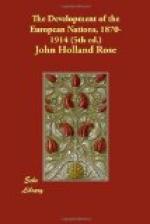Having now briefly shown the causes of the helplessness of the monarchical majority in the matter that it had most nearly at heart, we must pass over subsequent events save as they refer to that crowning paradox—the establishment of a Republican Constitution. This was due to the despair felt by many of the Orleanists of seeing a restoration during the lifetime of the Comte de Chambord, and to the alarm felt by all sections of the monarchists at the activity and partial success of the Bonapartists, who in the latter part of 1874 captured a few seats. Seeking above all things to keep out a Bonaparte, they did little to hinder the formation of a Constitution which all of them looked on as provisional. In fact, they adopted the policy of marking time until the death of the Comte de Chambord—whose hold on life proved to be no less tenacious than on his creed—should clear up the situation. Accordingly, after many diplomatic delays, the Committee which in 1873 had been charged to draw up the Constitution, presented its plan, which took form in the organic laws of February 25, 1875. They may be thus summarised:—
The Legislature consists of two Assemblies—the Chamber of Deputies and the Senate, the former being elected by “universal” (or, more properly, manhood) suffrage. The composition of the Senate, as determined by a later law, lies with electoral bodies in each of the Departments; these bodies consist of the national deputies for that Department, the members of their General Councils and District Councils, and delegates from the Municipal Councils. Senators are elected for nine years; deputies to the Chamber of Deputies for four years. The President of the Republic is chosen by the Senate and the Chamber of Deputies sitting together for that purpose. He is chosen for seven years and is eligible for re-election; he is responsible to the Chambers only in case of high treason; he enjoys, conjointly with the members of the two Chambers, the right of proposing laws; he promulgates them when passed and supervises their execution; he disposes of the armed forces of France and has the right of pardon formerly vested in the Kings of France. Conformably to the advice of the Senate he may dissolve the Chamber of Deputies. Each Chamber may initiate proposals for laws, save that financial measures rest solely with the Chamber of Deputies.
The Chambers may decide that the Constitution shall be revised. In that case, they meet together, as a National Assembly, to carry out such revision, which is determined by the bare majority. Each arrondissement, or district of a Department, elects one deputy. From 1885 to 1889 the elections were decided by each Department on a list, but since that time the earlier plan has been revived. We may also add that the seat of government was fixed at Versailles; four years later this was altered in favour of Paris, but certain of the most important functions, such as the election of a new President, take place at Versailles.




